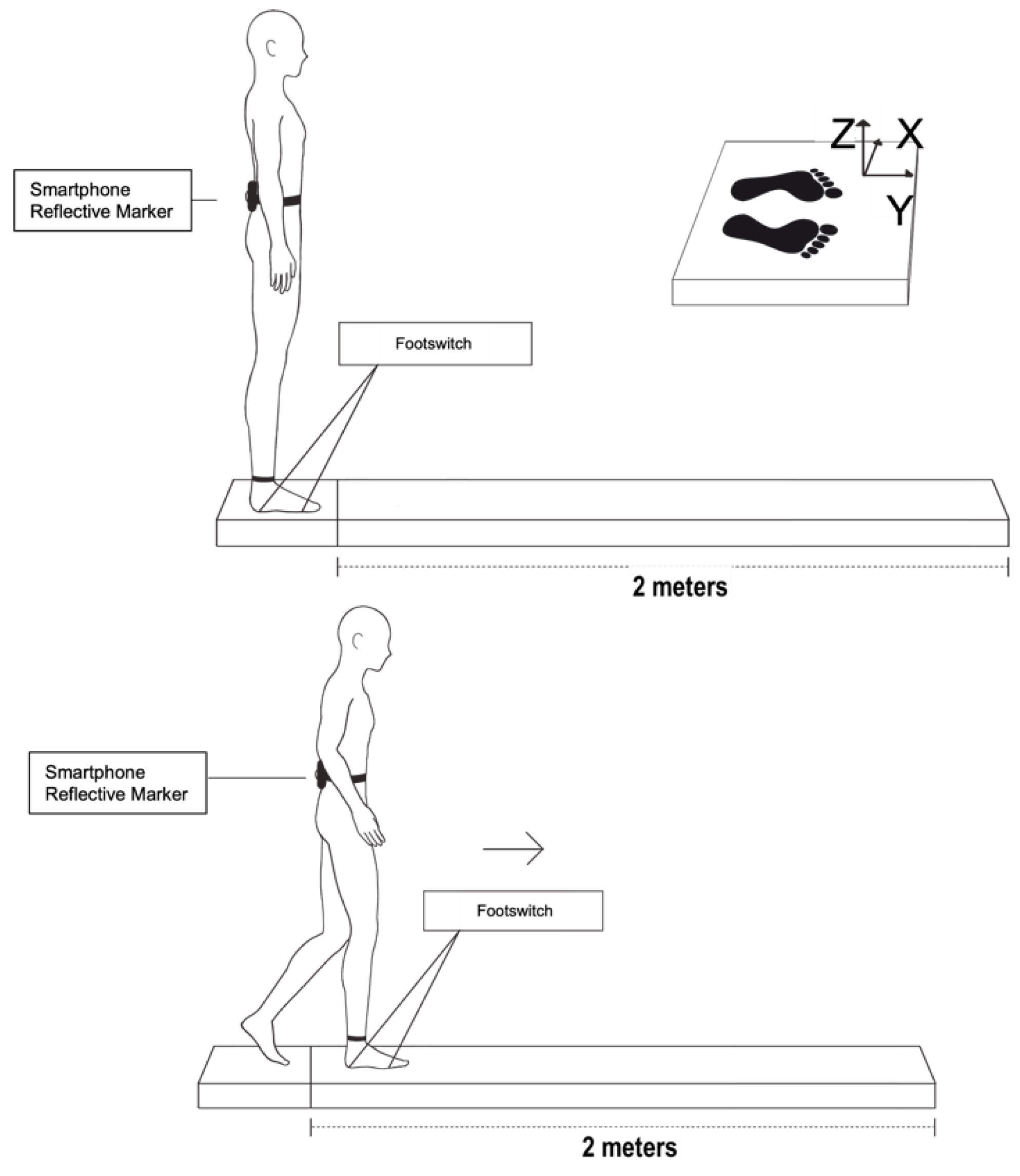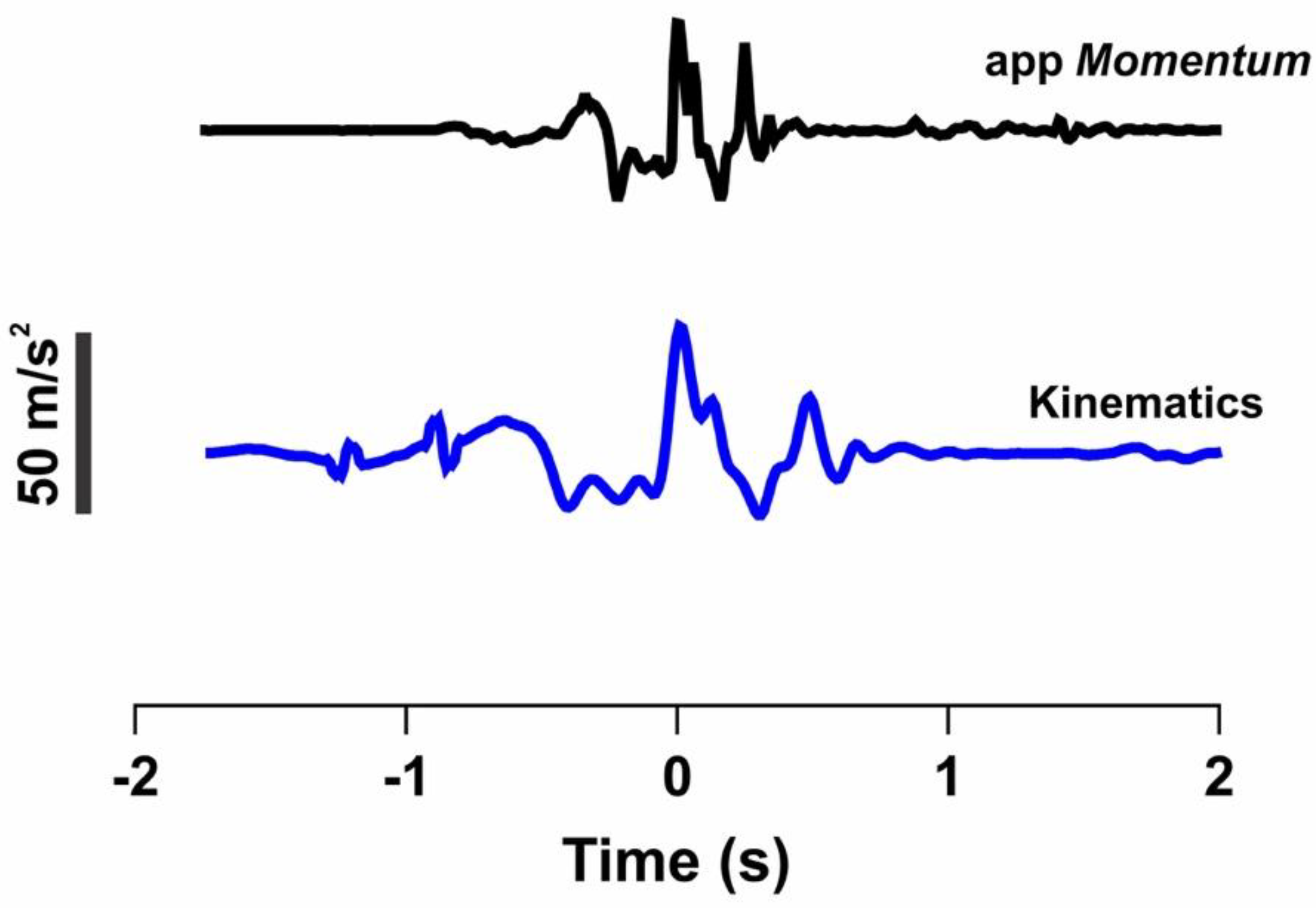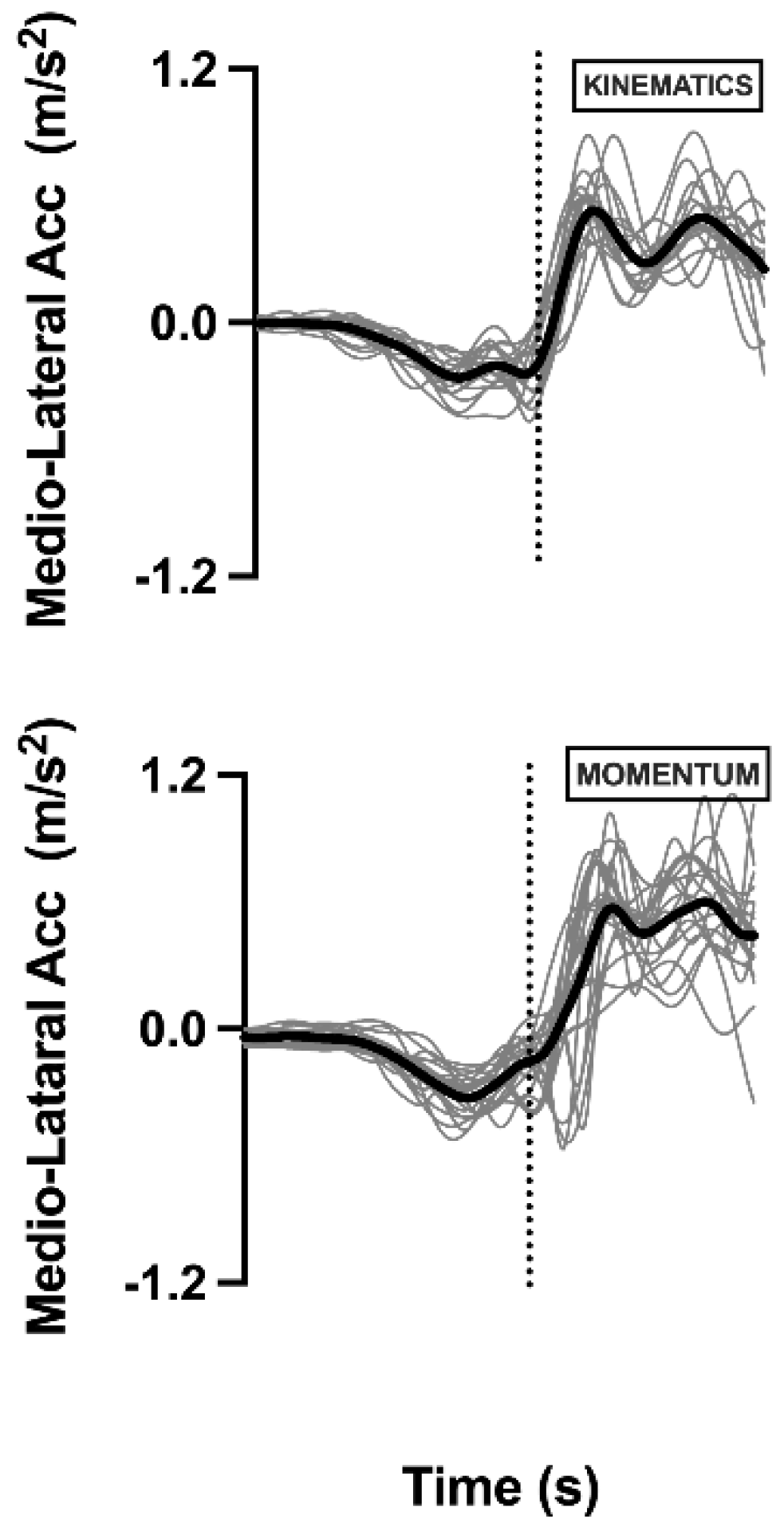Validity and Reliability of Smartphone App for Evaluating Postural Adjustments during Step Initiation
Abstract
:1. Introduction
2. Materials and Methods
2.1. Subjects
2.2. Instruments
2.3. Experimental Protocol
2.4. Signal Processing
- (1)
- APAonset: this is the APA latency, the moment when the first mediolateral deviation that exceeds two standard deviations (SDs) above the baseline occurs;
- (2)
- APAamp: this is the maximum mediolateral displacement of the COM before the heel-off.
- (3)
- PEAKtime: this is the time taken to reach the maximum amplitude.
- (4)
- STEPpeak1: this is the first mediolateral deviation after the heel-off;
- (5)
- STEPpeak2: this is the second mediolateral deviation after the heel-off;
- (6)
- STEPinterval: this is the interval between two mid-side peaks.
2.5. Statistical Analysis
3. Results
3.1. Validation
3.2. Reliability
4. Discussion
Author Contributions
Funding
Institutional Review Board Statement
Informed Consent Statement
Data Availability Statement
Acknowledgments
Conflicts of Interest
References
- Delafontaine, A.; Vialleron, T.; Hussein, T.; Yiou, E.; Honeine, J.L.; Colnaghi, S. Anticipatory postural adjustments during gait initiation in stroke patients. Front. Neurol. 2019, 10, 352. [Google Scholar] [CrossRef] [PubMed]
- Gélat, T.; Coudrat, L.; Ferrel-Chapus, C.; Vernazza-Martin, S. The duration of emotional image exposure does not impact anticipatory postural adjustments during gait initiation. Brain Sci. 2018, 8, 195. [Google Scholar] [CrossRef] [PubMed] [Green Version]
- Mochizuki, L.; Amadio, A.C. As funções do controle postural durante a postura ereta. Fisioter. E Pesqui. 2003, 10, 7–15. [Google Scholar] [CrossRef]
- Massion, J. Postural control system. Curr. Opin. Neurobiol. 1994, 4, 877–887. [Google Scholar] [CrossRef]
- Piscitelli, D.; Falaki, A.; Solnik, S.; Latash, M.L.; Education, P. Predictable and Unpredictable Direction. Exp. Brain Res. 2017, 235, 713–730. [Google Scholar] [CrossRef]
- Mancini, M.; Chiari, L.; Holmstrom, L.; Salarian, A.; Horak, F.B. Validity and reliability of an IMU-based method to detect APAs prior to gait initiation. Gait Posture 2016, 43, 125–131. [Google Scholar] [CrossRef] [Green Version]
- Varghese, J.P.; Merino, D.M.; Beyer, K.B.; McIlroy, W.E. Cortical control of anticipatory postural adjustments prior to stepping. Neuroscience 2016, 313, 99–109. [Google Scholar] [CrossRef] [PubMed]
- Ellmers, T.J.; Maslivec, A.; Young, W.R. Fear of Falling Alters Anticipatory Postural Control during Cued Gait Initiation. Neuroscience 2020, 438, 41–49. [Google Scholar] [CrossRef]
- Plate, A.; Klein, K.; Pelykh, O.; Singh, A.; Bötzel, K. Anticipatory postural adjustments are unaffected by age and are not absent in patients with the freezing of gait phenomenon. Exp. Brain Res. 2016, 234, 2609–2618. [Google Scholar] [CrossRef]
- Porciuncula, F.; Roto, A.V.; Kumar, D.; Davis, I.; Roy, S.; Walsh, C.J.; Awad, L.N. Wearable Movement Sensors for Rehabilitation: A Focused Review of Technological and Clinical Advances. PM R 2018, 10, S220–S232. [Google Scholar] [CrossRef] [Green Version]
- Horak, F.B.; Mancini, M. Objective biomarkers of balance and gait for Parkinson’s disease using body-worn sensors. Mov. Disord. 2013, 28, 1544–1551. [Google Scholar] [CrossRef] [PubMed] [Green Version]
- Maetzler, W.; Domingos, J.; Srulijes, K.; Ferreira, J.J.; Bloem, B.R. Quantitative wearable sensors for objective assessment of Parkinson’s disease. Mov. Disord. 2013, 28, 1628–1637. [Google Scholar] [CrossRef]
- Sampaio, L.V.P.; Castilho, L.B.; de Azevedo Carvalho, G. Development of an application for mobile devices to evaluate the balance and risk of falls of the elderly. Rev. Bras. Geriatr. Gerontol. 2017, 20, 805–813. [Google Scholar] [CrossRef] [Green Version]
- Lee, N.G.; You, J.; Sung, H.; Yi, C.H.; Jeon, H.S.; Choi, B.S.; Lee, D.R.; Park, J.M.; Lee, T.H.; Ryu, I.T.; et al. Best Core Stabilization for Anticipatory Postural Adjustment and Falls in Hemiparetic Stroke. Arch. Phys. Med. Rehabil. 2018, 99, 2168–2174. [Google Scholar] [CrossRef] [PubMed]
- Arcuria, G.; Marcotulli, C.; Amuso, R.; Dattilo, G.; Galasso, C.; Pierelli, F.; Casali, C. Developing a smartphone application, triaxial accelerometer-based, to quantify static and dynamic balance deficits in patients with cerebellar ataxias. J. Neurol. 2020, 267, 625–639. [Google Scholar] [CrossRef]
- Hsieh, K.L.; Roach, K.L.; Wajda, D.A.; Sosnoff, J.J. Smartphone technology can measure postural stability and discriminate fall risk in older adults. Gait Posture 2019, 67, 160–165. [Google Scholar] [CrossRef] [PubMed]
- Cohen, H.S. A review on screening tests for vestibular disorders. J. Neurophysiol. 2019, 122, 81–92. [Google Scholar] [CrossRef]
- Martinez-Mendez, R.; Sekine, M.; Tamura, T. Detection of anticipatory postural adjustments prior to gait initiation using inertial wearable sensors. J. Neuroeng. Rehabil. 2011, 8, 17. [Google Scholar] [CrossRef] [Green Version]
- Abbott, J.C.; Wagle, J.P.; Sato, K.; Painter, K.; Light, T.J.; Stone, M.H. Validation of Inertial Sensor to Measure Barbell Kinematics across a Spectrum of Loading Conditions. Sports 2020, 8, 93. [Google Scholar] [CrossRef]
- Shrout, P.E.; Fleiss, J.L. Intraclass correlations: Uses in assessing rater reliability. Psychol. Bull. 1979, 86, 420–428. [Google Scholar] [CrossRef]
- Al-Amri, M.; Nicholas, K.; Button, K.; Sparkes, V.; Sheeran, L.; Davies, J.L. Inertial measurement units for clinical movement analysis: Reliability and concurrent validity. Sensors 2018, 18, 719. [Google Scholar] [CrossRef] [PubMed] [Green Version]
- Roeing, K.L.; Hsieh, K.L.; Sosnoff, J.J. A systematic review of balance and fall risk assessments with mobile phone technology. Arch. Gerontol. Geriatr. 2017, 73, 222–226. [Google Scholar] [CrossRef] [PubMed]
- Fiems, C.L.; Miller, S.A.; Buchanan, N.; Knowles, E.; Larson, E.; Snow, R.; Moore, E.S. Does a Sway-Based Mobile Application Predict Future Falls in People With Parkinson Disease? Arch. Phys. Med. Rehabil. 2020, 101, 472–478. [Google Scholar] [CrossRef] [PubMed]
- Polechonski, J.; Nawrocka, A.; Wodarski, P.; Tomik, R. Applicability of Smartphone for Dynamic Postural Stability Evaluation. BioMed Res. Int. 2019, 2019, 9753898. [Google Scholar] [CrossRef] [PubMed] [Green Version]
- Goldie, P.A.; Matyas, T.A.; Evans, O.M. Gait after stroke: Initial deficit and changes in temporal patterns for each gait phase. Arch. Phys. Med. Rehabil. 2001, 82, 1057–1065. [Google Scholar] [CrossRef]
- Abou, L.; Peters, J.; Wong, E.; Akers, R.; Sènan, M.; Jacob, D.; Rice, L.A. Gait and Balance Assessments using Smartphone Applications in Parkinson’s Disease: A Systematic Review. J. Med. Syst. 2021, 45, 87. [Google Scholar] [CrossRef]
- Su, D.; Liu, Z.; Jiang, X.; Zhang, F.; Yu, W.; Ma, H.; Wang, C.; Wang, Z.; Wang, X.; Hu, W.; et al. Simple smartphone-based assessment of gait characteristics in Parkinson disease: Validation study. JMIR Mhealth Uhealth 2021, 9, e25451. [Google Scholar] [CrossRef]
- Clavijo-Buendía, S.; Molina-Rueda, F.; Martín-Casas, P.; Ortega-Bastidas, P.; Monge-Pereira, E.; Laguarta-Val, S.; Morales-Cabezas, M.; Cano-de-la-Cuerda, R. Construct validity and test-retest reliability of a free mobile application for spatio-temporal gait analysis in Parkinson’s disease patients. Gait Posture 2020, 79, 86–91. [Google Scholar] [CrossRef]
- Tang, S.T.; Tai, C.H.; Yang, C.Y.; Lin, J.H. Feasibility of Smartphone-Based Gait Assessment for Parkinson’s Disease. J. Med. Biol. Eng. 2020, 40, 582–591. [Google Scholar] [CrossRef]






| Variable | ICC | Lower Limit | Upper Limit | F | df1 | Df2 | p-Value |
|---|---|---|---|---|---|---|---|
| APAonset | |||||||
| Kinematics | 0.014 | −1.072 | 0.570 | 1.016 | 20 | 20.196 | 0.485 |
| Momentum | 0.185 | −0.633 | 0.635 | 1.279 | 20 | 20.506 | 0.291 |
| APAamp | |||||||
| Kinematics | 0.266 | −0.633 | 0.689 | 1.397 | 20 | 20.959 | 0.226 |
| Momentum | 0.451 | −0.381 | 0.779 | 1.795 | 20 | 20.347 | 0.098 |
| PEAKtime | |||||||
| Kinematics | −0.284 | −2.151 | 0.484 | 0.742 | 20 | 9.31 | 0.725 |
| Momentum | 0.002 | −1.343 | 0.597 | 1.021 | 20 | 20.105 | 0.481 |
| STEPpeak1 | |||||||
| Kinematics | 0.672 | 0.200 | 0.866 | 3.031 | 20 | 20.829 | 0.007 |
| Momentum | 0.709 | 0.274 | 0.882 | 3.347 | 20 | 20.237 | 0.004 * |
| STEPpeak2 | |||||||
| Kinematics | 0.148 | −1.001 | 0.647 | 1.179 | 20 | 20.660 | 0.355 |
| Momentum | 0.384 | −0.406 | 0.742 | 1.674 | 20 | 20.829 | 0.125 |
| STEPinterval | |||||||
| Kinematics | 0.380 | −0.508 | 0.747 | 1.614 | 20 | 20.772 | 0.142 |
| Momentum | 0.402 | −0.387 | 0.751 | 1.711 | 20 | 20.953 | 0.115 |
| Study | Device | Variable | Validity Comfirmed |
|---|---|---|---|
| Present | Mobile | APAonset; PEAKtime; APAamp; STEPpeak1; STEPpeak2, STEPinterval | yes |
| Mancini et al., 2016 | IMU | APA duration; APA amplitude. Step spatiotemporal parameters | yes |
| Martinez-Mendez et al., 2011 | IMU | APA duration; APA amplitude. | In part |
Publisher’s Note: MDPI stays neutral with regard to jurisdictional claims in published maps and institutional affiliations. |
© 2022 by the authors. Licensee MDPI, Basel, Switzerland. This article is an open access article distributed under the terms and conditions of the Creative Commons Attribution (CC BY) license (https://creativecommons.org/licenses/by/4.0/).
Share and Cite
da Costa Moraes, A.A.; Duarte, M.B.; Ferreira, E.V.; da Silva Almeida, G.C.; da Rocha Santos, E.G.; Pinto, G.H.L.; de Oliveira, P.R.; Amorim, C.F.; Cabral, A.d.S.; de Athayde Costa e Silva, A.; et al. Validity and Reliability of Smartphone App for Evaluating Postural Adjustments during Step Initiation. Sensors 2022, 22, 2935. https://doi.org/10.3390/s22082935
da Costa Moraes AA, Duarte MB, Ferreira EV, da Silva Almeida GC, da Rocha Santos EG, Pinto GHL, de Oliveira PR, Amorim CF, Cabral AdS, de Athayde Costa e Silva A, et al. Validity and Reliability of Smartphone App for Evaluating Postural Adjustments during Step Initiation. Sensors. 2022; 22(8):2935. https://doi.org/10.3390/s22082935
Chicago/Turabian Styleda Costa Moraes, Anderson Antunes, Manuela Brito Duarte, Eduardo Veloso Ferreira, Gizele Cristina da Silva Almeida, Enzo Gabriel da Rocha Santos, Gustavo Henrique Lima Pinto, Paulo Rui de Oliveira, César Ferreira Amorim, André dos Santos Cabral, Anselmo de Athayde Costa e Silva, and et al. 2022. "Validity and Reliability of Smartphone App for Evaluating Postural Adjustments during Step Initiation" Sensors 22, no. 8: 2935. https://doi.org/10.3390/s22082935







